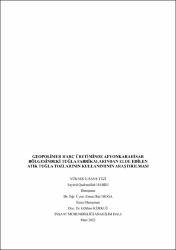Geopolimer harç üretiminde Afyonkarahisar bölgesindeki tuğla fabrikalarından elde edilen atık tuğla tozlarının kullanımının araştırılması
Özet
Afyonkarahisar bölgesinde yaklaşık yirmi adet tuğla fabrikası vardır ve bu fabrikalarda hatalı üretimlerin sonucunda ya da taşıma sırasında parçalanma sebebiyle oldukça fazla oranda atık tuğla parçaları ve tozları ortaya çıkmaktadır. Bu tez çalışmasında Afyonkarahisar bölgesinde üretilen pişirilmiş kil tuğlalarına ait atık tuğlaların öğütülmesi ile elde edilen tuğla tozları kullanılmıştır. Beş farklı tuğla fabrikası üretim teknolojilerine göre belirlenmiştir. Atık tuğla tozları ile ikame edilerek kullanılacak diğer hammadde olarak uçucu kül seçilmiştir. Harç üretiminde agrega olarak silis kumu kullanılmıştır. Alkali aktivatör olarak ise NaOH ve Na2SiO3 kullanılmıştır. Farklı atık tuğla tozları (T1, T2, T3, HT1 ve HT2) ve farklı molaritelerde (5 ve 10M) üretilen geopolimer harçlarının fiziksel ve mekanik özellikleri belirlenmiştir. Üretilen tüm numuneler 80oC sıcaklıktaki etüvde 5 saat boyunca kürlenmiştir. Etüv kürü sonrasında numuneler 28 gün boyunca laboratuvar ortamında bekletilmiştir. Silindir şeklinde hazırlanan numuneler üzerinde birim hacim ağırlık, görünür yoğunluk, görünen porozite, su emme, ultrases geçiş hızı, basınç dayanımı ve yüksek sıcaklık deneyleri yapılmıştır. Üretilen silindir numunelerden elde edilen sonuçlara göre bazı geopolimer harç serileri seçilerek levha ve disk şeklinde numuneler üretilmiş ve bu numuneler üzerinde de eğilme dayanımı, elektriksel özdirenç ve yüzey sıcaklığı deneyleri yapılmıştır. Elde edilen verilere göre atık tuğla tozları ile geopolimer harçların üretilebileceği sonucuna varılmıştır. There are about twenty brick factories in the Afyonkarahisar region, so that a lot of waste brick pieces and dust are produced in these factories as a result of faulty production or due to fragmentation during transportation. In this thesis, brick powders obtained by recycling waste bricks belonging to fired clay bricks produced in the Afyonkarahisar region are used. Five different brick factories were determined according to their production technologies. Fly ash was chosen as the other raw material to be used as a substitute for waste brick dust. Silica sand was used as aggregate in mortar production. NaOH and Na2SiO3 were used as alkali activators. Physical and mechanical properties of geopolymer mortars produced in different waste brick powders (T1, T2, T3, HT1 and HT2) and different molarities (5 and 10M) were determined. All produced samples were heated in an oven at 80oC for 5 hours. After the oven cure, the samples were kept in the laboratory environment for 28 days. Unit weight, apparent density, apparent porosity, water absorption, ultrasonic pulse velocity, compressive strength and high temperature tests were performed on the cylindrical specimens. According to the results obtained from the produced cylindrical samples, some geopolymer mortar series were selected, plate and disk-shaped samples were produced, flexural strength, electrical resistivity and surface temperature tests were carried out on these samples. According to the obtained data, it was concluded that geopolymer mortars can be produced with waste brick dust.
Bağlantı
https://hdl.handle.net/11630/10040Koleksiyonlar
- Yüksek Lisans Tezleri [890]



















